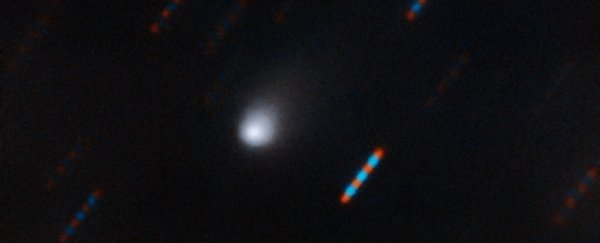The verdict is in: after a thorough round of observations, the comet suspected of being an interstellar alien has been ratified. According to the International Astronomical Union (IAU), the comet is "unambiguously" interstellar in origin, and it has now been given a name: 2I/Borisov.
Previously, the comet had been going by the provisional name C/2019 Q4 (Borisov). C means it's a comet with a hyperbolic orbit, followed by the year it was discovered, an alphanumeric code for when in the year it was discovered, and the comet name in parentheses - that's Crimean amateur astronomer Gennadiy Borisov, who spotted the comet with telescope he made himself.
The new name has been simplified. In 2I, I stands for "interstellar", and 2 for being the second interstellar object ever discovered, after 'Oumuamua, which was detected in October 2017.
"In this case, the IAU has decided to follow the tradition of naming cometary objects after their discoverers, so the object has been named 2I/Borisov," the IAU wrote.
Astronomers haven't just been busy labelling the object; they have been furiously studying the comet to try and find out more about it.
According to observations and analysis so far, the comet is currently inbound towards the Sun, and will reach its closest approach (perihelion) on December 8 at a distance of 300 million kilometres (190 million miles) - about twice the average distance of Earth from the Sun.
 The green line shows 2I/Borisov's estimated trajectory. (Tony Dunn/Twitter)
The green line shows 2I/Borisov's estimated trajectory. (Tony Dunn/Twitter)
The comet is approaching the planetary orbital plane - the ecliptic - at an angle of around 40 degrees, and is travelling at a breakneck 150,000 kilometres per hour (93,000 mph). It's between 2 and 16 kilometres (1.2 and 10 miles) in diameter, and images of the object show a fuzzy outline typical of cometary outgassing, and even a tail.
Two recent analyses - one of the optical images showing the comet's colour, the other of the comet's spectra revealing its chemical composition - have revealed that it is similar to the Solar System's long-period comets that originate in the distant Oort Cloud, rather than the short-period comets that come from closer in.
And a new paper just published by Polish astronomers on pre-print resource arXiv may have traced the comet's trajectory to try and pinpoint where it came from.
The results didn't conclusively point to an origin, but the paper suggests that, around a million years ago, 2I/Borisov passed the binary star Kruger 60 that's located 13 light-years away. The comet 'skimmed' that star at a relatively close distance of 5.7 light-years, and at a lower velocity than the one it has currently - just 12,348 kilometres per hour.
Obviously that's a very preliminary result - plotting an accurate trajectory is going to take months of observations, and studying the comet itself may yet yield some surprises.
In particular, it will be exciting to see just how closely similar it really is to Solar System comets, and if there are any noticeable differences.
The discovery, less than two years after the discovery of 'Oumuamua, also shows that perhaps these interstellar visitors are not rare at all.
We can't wait to meet 3I, 4I, 5I…
